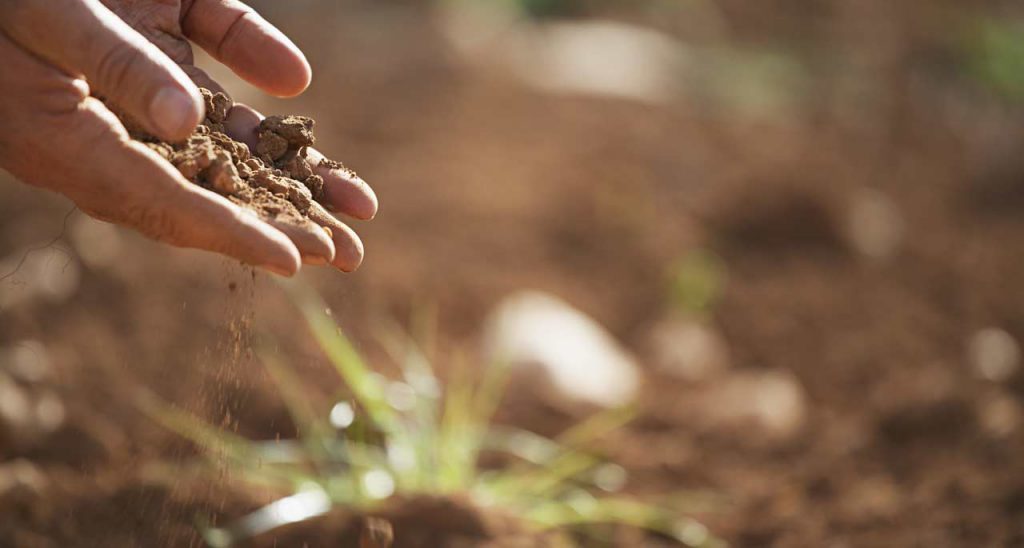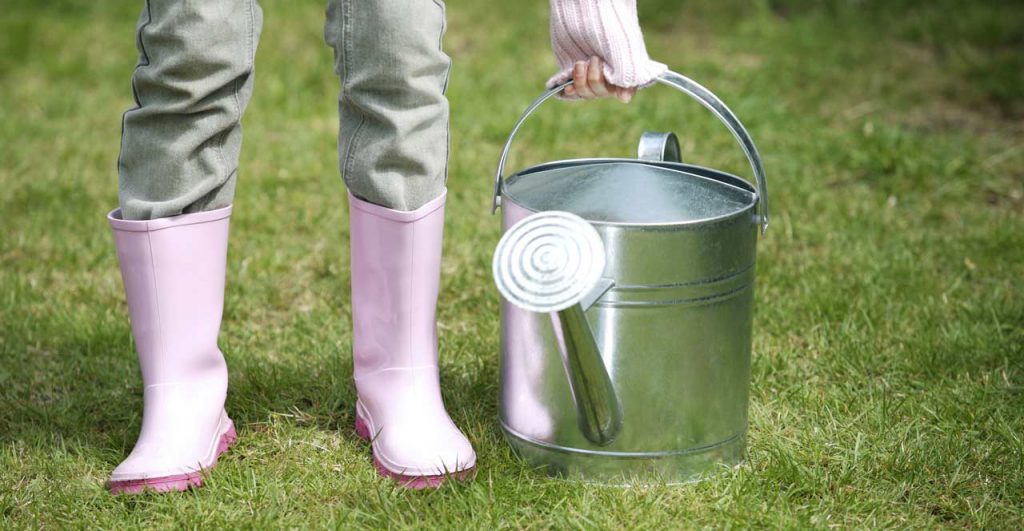
If you are proud of your yard you will want a lush and healthy looking lawn.
Learning how to seed a lawn may seem like a daunting task, but…
It need not be – follow our guide and you will have a beautiful lawn seeded in no time!
So where do you start?
Well, the first step in having that lawn you desire involves seeding it.
Seeding is the term used to describe the act of planting grass using seeds instead of laying patches of pre-planted grass called sod.
Seeding is mostly done on previously barren areas to set up new lawns but it can also be done on an already existing lawn to cover bare patches and replace old grass.
Right – let’s get cracking.
Seeding A New Lawn
Seeding a new lawn from scratch is by no means an easy job. It involves plenty of work, most of which has to be done by hand, and the results take time before they become visible. But good things never come easy, and the effort you put into this project will be worth the reward.
So:
In this article we break down the process of seeding a new lawn into simple steps to make your work much easier.
Choosing A Grass Variety
Before seeding a new lawn, you must first choose a grass variety that matches your aesthetic requirements.
And just as importantly…
The grass you choose also has to be able to flourish in the climatic conditions present in your area while also being able to handle the level of foot traffic that you expect on your lawn.
Owing to the fact that grass is a seasonal plant, you will also have to find out the ideal season for planting the species you choose.
Cool Season Or Warm Season?
Grass species can be categorized into two broad categories; cool season and warm season grasses.
Let me explain:
Cool season grasses thrive in areas that often experience harsh winters where the temperature occasionally drops to below zero. Such grasses however become dormant and can turn brown during hot summer seasons.
In the United States these grass varieties flourish in the northern states which are known to have a cool climate.
Cool season grasses should ideally be planted during the fall season to provide adequate time for the seeds to germinate and grow before the hot summer temperature kicks in.
Whereas:
Warm season grasses grow best in areas that experience high temperatures during summer and have mild winters. Such grass varieties are mostly of the creeping kind. They are generally regarded as drought resistant grasses since they require very little water to grow.
Warm season grasses however tend to wither and die when the temperature drops below the freezing point.
To put it simply:
In the United States, this type of grass is best suited for the southern states which experience long hot summers and mild winters.
The best time to seed warm season grass during summer or spring seasons when the weather is warm and conducive for their seeds to germinate.
The video below will give you some quick tips:
How To Seed A Lawn
As someone who has never seeded a lawn before, all this information on grass species might seem too complicated and you might not know where to start.
That shouldn’t bother you too much.
Your local seed supplier will guide you through the whole process of selecting the best type of grass for your lawn.
Now that you have an idea of what type of grass you are going to go for, it’s time to get to work.
What you will need:
- A strong garden rake
- A weighted garden roller
- A water hose and sprinklers
- Grass seeds
- A pair of heavy duty latex gloves (not necessary if you don’t mind getting your hands dirty)
- A hand-operated seed spreader (for large lawns covering more than half an acre)
- A soil pH testing kit
- A shovel
First Step – Tilling The Ground
First things first:
Before you start tilling the ground, you will need to clear any vegetation or visible debris from the surface.
Use a shovel to uproot any unwanted plants. The garden rake can be used to remove debris such as rocks and small twigs.
Alternatively, you could hand-pick visible debris from the ground since a rake might fail to gather smaller rocks and twigs.
Ok, done that?
You will then need to ensure that the ground is level. This is necessary if you want to achieve a flat and uniform lawn.
Drag the rake firmly over the surface to spread the soil evenly and to fill any depressions with soil.
Raking also serves another important purpose: it loosens up the top soil and breaks down any large lumps of soil. The top soil has to be loose up to a depth of 3cm from the surface.
You are well on your way now.
Second Step – Preparing The Soil
This stage involves checking the pH and adding nutrients to the top soil. The pH value is a measure of the soil’s acidity or alkalinity.
This is important:
The ideal pH level for germination of grass seeds needs to be between 6 and 7.5.
Collect a small sample of soil from the ground and mix it with an equal volume of water. Place this mixture into the pH testing kit and shake it.
After about a minute the color of the mixture will turn into a shade of either blue or red.
The key is:
To use the color chart that came with the testing kit to match the color of the mixture to the corresponding pH value on the chart.
If the reading is below 6, the soil is too acidic and if it is above 7.5 then it is too alkaline.
Don’t worry, if that is the case all is not lost.
Acidity can be brought down by using lime while alkalinity can be reduced by adding sulfur into the soil. To mix sulfur or lime into the soil, you can scoop a handful of whichever is needed and sprinkle it over the ground surface.
Repeat this until the entire ground is covered but don’t mix it yet until you add fertilizer.
Hope you are still with me!
With the soil’s pH having been taken care of, you can now add fertilizer and compost into the soil. These will ensure that the seeds get all the nutrients they require to germinate.
Alternatively, you can purchase a pre-mixed top-soil formulation from a gardening supplies store. Such formulations contain all the vital nutrients and therefore require no additional fertilizer.
You can now use a rake to evenly mix and spread the lime/sulfur, fertilizer, compost manure or pre-mixed formulation into the top soil.

Third Step – Planting The Seeds
Having gone through the tedious process of tilling and preparing the ground, the soil will now be ready for planting. Collect the seeds from the bag and begin dispersing them over the ground.
It is a bit boring, but you have to get it done I am afraid!
To ensure the seeds are spread uniformly over the lawn, sow the seeds from a height of about three feet from the ground.
It is also advisable to follow an L-shape pattern while sowing: disperse half the seeds in a straight line then repeat the process in another straight line perpendicular to the first.
Ensure that the entire lawn is covered to avoid bare patches when the grass germinates. To achieve a good grass density, use at least 30 grams of seeds for each square meter.
Ok you are ready to move on.
Once the entire ground has been covered with seeds, use a rake to cover the seeds with a layer of soil. Do not rake the soil too hard as this may cause uneven distribution of the sown seeds.
Light raking strokes will do the job. You can now push the garden roller over the lawn to compact the top soil and to ensure that the seeds maintain a firm contact with the soil.
Fourth Step – Watering The Lawn
Now that the seeds have finally been planted you are almost there now, but there is still a little work to be done. The seeds will need to get some water before they germinate.
But we are almost there now, I promise!
Connect your sprinkler to a water outlet and let it sprinkle water evenly around the lawn. Ensure that the entire lawn is watered but don’t allow too much water to saturate the soil.
For the first two to three weeks before the grass germinates, you will have to water the ground twice daily, preferably in the morning and evening.
After that:
The grass should have germinated and you can reduce the watering frequency to once a day. In about two months, the grass will reach a height of about 3 inches.
At this stage you can mow it for the first time. Be careful not to mow it down to a height lower than an inch as this could kill the young grass shoots.
And bingo you are done!

Possible Problems
The process of seeding a lawn may on some occasions not go as smoothly as it should. Here are some of the common problems experienced and how you can avoid them:
1. Germination Problems
The grass seeds you plant may have a poor rate of germination or in some extreme cases not even germinate at all. This is mostly caused by sowing poor quality or expired seeds.
To avoid having to go through this you should only purchase seeds from well-established suppliers and always check the expiry date of the seeds before you purchase them.
And this is HUGE:
Using weed killers on the soil before planting the seeds can also cause total germination failure. You should never use weed killers on the soil before you plant the grass or even on young grass that is under six months old.
Weed issues should only be tackled after the grass has been mowed three times or more.
Finally:
Avoid saturating the soil with too much water after planting the seeds. A high water content in the soil can choke the seeds and result in rotting before they germinate.
2. Patches In The Lawn
Some noticeable bare patches may be visible on the lawn as the grass germinates. This is caused by the uneven distribution of seeds on the surface after sowing.
To avoid this you should make sure that you miss no spots while dispersing the seeds.
Caring For Your New Lawn
It’s wonderful to see a beautiful lawn taking shape in your backyard after all the hard work you put in. You now have to take good care of it to ensure that it looks good at all times.
The following steps can be followed to keep your lawn pristine:
- Don’t stop watering the lawn after the grass germinates. After germination, it is advisable to water the lawn at least once daily for a period of 60 days.
- Do not mow the new lawn until the grass gets to 3 inches in height, and even when it does, don’t cut the grass to below 1 inch in height. You can only start mowing regularly when the grass sprigs have fully developed.
- After mowing the grass a couple of times, some blades may start turning yellow. This mostly means that the fertilizer in the soil has been used up and you need to apply more fertilizer. Until you notice this yellowing, don’t be in a rush to add any fertilizer to the soil.
- Young grass plants are usually very delicate and the tender shoots easily get damaged when put under physical stress. You should therefore limit the foot traffic on the lawn for the first three to four months after planting to give the grass sufficient time to mature.
That’s it. Now spread your seed – so to speak!
USEFUL RESOURCES
Want to learn more about caring for your lawn, you can find more information here:


Great post.
I have just re-seeded our lawn and wish I had read this first. After several weeks the Seed had done nothing and I was worried It was not going to take but after the weather began to pick up I finally started to see some green poking through.
Now after nearly 6 weeks my Lawn is begging to look something like. I’m sure if I had followed your tips rather than just wildly throwing seed around at random I would have had better success.
Steve
I guess you live and learn, so at least you won’t make the same mistake again! Sure your lawn will be looking in tip top condition in no time at all 🙂
Hi Steve
What an interesting article. We have a huge lawn which needs a bit of tlc. I can’t say I really want to dig it all up and seed a new one but would like to ‘pep it up a bit’. Do you have any suggestions on how to do this?
Don’t you just love Alan Titchmarsh:)?
Jackie
Thanks Jackie! There are a few ways you can do this – you can aerate your lawn (basically punch holes in it up to 3 inches deep) to encourage better air circulation, you can use natural lawn fertilizers, leave your grass cuttings on your lawn after you mow it and put compost on it. Those are just a few ways to improve your lawn.
Alternatively you can just hire good old Alan Titchmarsh!